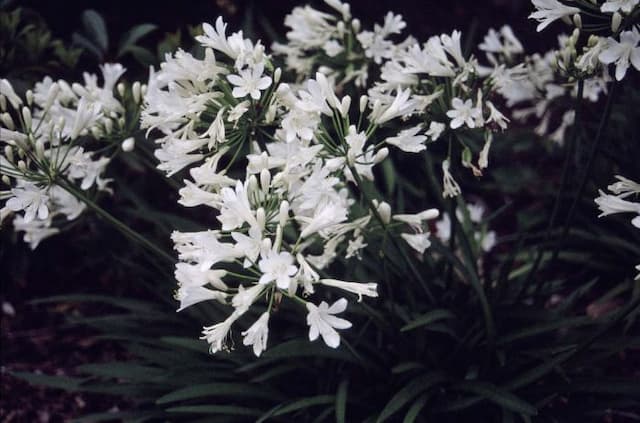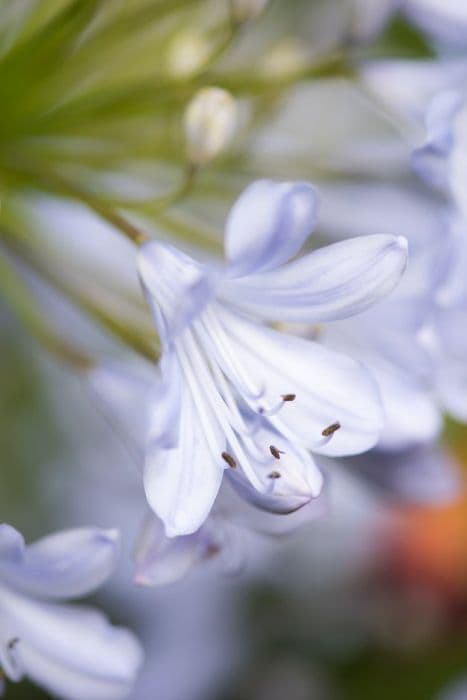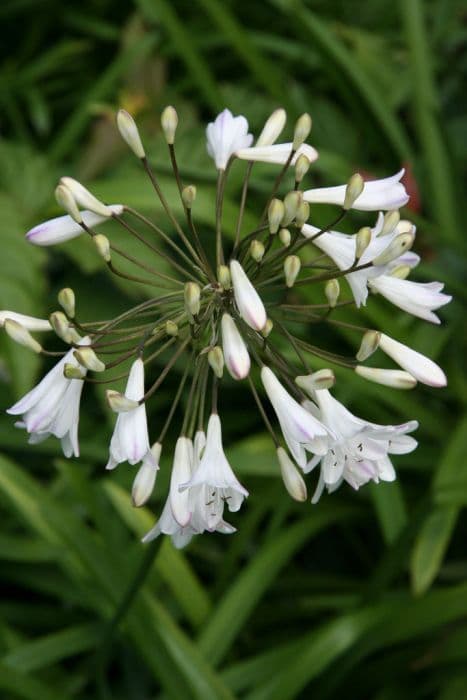Lily of the Nile Agapanthus 'Summer Days'

ABOUT
Agapanthus 'Summer Days' presents itself as a striking plant, primarily known for its beautiful display of flowers. The plant showcases clusters of trumpet-shaped blooms that gather in rounded umbels at the top of slender, upright stems. These blossoms are often a soft blue or white tint, adding a soothing palette to the garden. The individual flowers within each cluster provide a delicate and intricate visual texture. Beneath the clusters of blooms, Agapanthus 'Summer Days' features lush, strap-like foliage with a glossy surface. The leaves form a dense clump, creating a lush backdrop that contrasts with the flowers and accentuates their beauty. The green of the foliage is deep and rich, providing a perennial sense of vitality and vigor. The overall impression of Agapanthus 'Summer Days' is one of elegance and subtlety, making it a favorite among gardeners seeking to add a touch of sophistication to their plantings without overwhelming their space. The plant is well-suited for borders, containers, or as a specimen plant, where its floral display can be admired up close.
About this plant
 Names
NamesFamily
Amaryllidaceae
Synonyms
African Lily, Lily of the Nile, Love Flower
Common names
Agapanthus 'Summer Days'
 Toxicity
ToxicityTo humans
The Agapanthus, commonly known as Lily of the Nile, is considered to have a low level of toxicity to humans. If ingested, parts of the plant may cause mild stomach upset, nausea, vomiting, or diarrhea. The sap can also cause skin irritation or dermatitis in sensitive individuals.
To pets
In pets, the Agapanthus, or Lily of the Nile, contains substances that can be toxic. If ingested by dogs or cats, it can cause vomiting, diarrhea, and sometimes lethargy or tremors. If you suspect your pet has ingested this plant, contact your veterinarian.
 Characteristics
CharacteristicsLife cycle
Perennials
Foliage type
Evergreen
Color of leaves
Green
Flower color
Blue
Height
2 feet (60 cm)
Spread
2 feet (60 cm)
Plant type
Bulb
Hardiness zones
8
Native area
South Africa
Benefits
 General Benefits
General Benefits- Attractive Flowers: Produces showy clusters of trumpet-shaped flowers that add visual appeal to gardens and landscapes.
- Low Maintenance: Requires minimal care once established, making it an ideal choice for busy gardeners.
- Drought Tolerant: Can thrive with limited water, suitable for xeriscaping or regions with water restrictions.
- Long Blooming Season: Offers a prolonged period of blooming, providing color and interest throughout the summer.
- Wildlife Attraction: Flowers attract various pollinators like bees, butterflies, and birds, enhancing biodiversity.
- Architectural Form: Its strappy leaves and tall flower stalks add structure and form to garden designs.
- Container Friendly: Can be grown in pots or containers, allowing for versatility in placement and space utilization.
- Coastal Tolerance: Resilient enough to grow in coastal areas subject to salt spray and sandy soil conditions.
 Medical Properties
Medical PropertiesThis plant is not used for medical purposes.
 Air-purifying Qualities
Air-purifying QualitiesThis plant is not specifically known for air purifying qualities.
 Other Uses
Other Uses- Agapanthus flowers can be used for ornamental table decor for weddings and events, adding elegance with their tall and striking blooms.
- The sturdy stems of Agapanthus can be utilized in the art of Ikebana, the Japanese art of flower arrangement, which emphasizes form and balance.
- Dried Agapanthus flower heads offer an exotic-looking element to dried flower arrangements and can be used in home decorations.
- Agapanthus can be planted to stabilize soil in erosion-prone areas because of its extensive root system.
- Due to its vibrant color and showy flowers, Agapanthus makes a striking addition to themed gardens, such as blue or purple color-themed gardens.
- The leaves of Agapanthus can be woven into small crafts or used as a natural ribbon in gardening to tie plants to supports.
- Agapanthus can be used as a companion plant in vegetable gardens to attract pollinators, assisting in the pollination of crops.
- Floral designers may use Agapanthus to create wearable art such as hair accessories or boutonnieres for special occasions.
- In photography, Agapanthus flowers can serve as an attractive foreground or background subject in garden and macro photography.
- Agapanthus can be used as a living fence or privacy screen in the garden due to its clumping growth habit and foliage density.
Interesting Facts
 Feng Shui
Feng ShuiThe Agapanthus, commonly known as Lily of the Nile, is not specifically used in Feng Shui practice.
 Zodiac Sign Compitability
Zodiac Sign CompitabilityThe Agapanthus, commonly known as Lily of the Nile, is not used in astrology practice.
 Plant Symbolism
Plant Symbolism- Love Letters: Agapanthus is often associated with love, and 'Summer Days' relates to the warmth and brightness of love, like letters sent between devoted lovers.
- Fertility: With its lush, full blossoms, the Agapanthus can symbolize fertility and abundance, echoing bountiful summer days.
- Beauty: The striking appearance of Agapanthus 'Summer Days' is a natural representation of beauty and elegance.
- Strength and Resilience: Agapanthus can thrive in challenging conditions, symbolizing the capacity to stem through adversity.
- Freedom: The plant's natural propensity to spread may exemplify the concept of freedom and liberty.
 Water
WaterLily of the Nile should be watered deeply, ensuring moisture reaches the roots, but allow soil to dry slightly between watering sessions. During the growing season, typically spring and summer, water about once a week with approximately 1-2 gallons depending on the size of the plant and environmental conditions. Cut back on watering in the fall and winter to prevent root rot, providing water every other week or as needed if the soil remains moist.
 Light
LightLily of the Nile thrives in full sun to partial shade. The best spot for this plant is in a garden area where it can receive at least six hours of direct sunlight each day, though it can tolerate some light afternoon shade. Avoid deeply shaded areas as inadequate light can hinder flowering.
 Temperature
TemperatureLily of the Nile can withstand a temperature range from around 50°F to 90°F, but the ideal growing temperature is between 70°F and 80°F. It can survive short periods of colder weather, but prolonged exposure to temperatures below 50°F can damage the plant.
 Pruning
PruningPrune Lily of the Nile after flowering to remove spent blooms, which encourages additional blooming and maintains plant shape. The best time for pruning is late summer or early fall. Cut back the flower stalks to the base, but leave the foliage, as it provides energy for the next season.
 Cleaning
CleaningAs needed
 Soil
SoilFor Lily of the Nile, the best soil mix is well-draining, fertile, and loamy. It should be amended with compost or peat moss to enhance fertility and drainage. A slightly acidic to neutral pH of 6.0 to 7.0 is ideal for optimal growth.
 Repotting
RepottingLily of the Nile should generally be repotted every 2 to 3 years to provide fresh soil and additional space for roots. It's best to repot in spring before the growing season starts.
 Humidity & Misting
Humidity & MistingLily of the Nile prefers moderate humidity levels but is quite adaptable and can tolerate the range of indoor humidity levels found in most homes.
 Suitable locations
Suitable locationsIndoor
Use bright, indirect light and well-draining soil.
Outdoor
Full sun to partial shade, and well-drained soil.
Hardiness zone
8-11 USDA
 Life cycle
Life cycleThe Agapanthus, commonly known as Lily of the Nile, starts its life as a seed, which germinates in moist soil with adequate warmth. After germination, a seedling emerges, developing a small rosette of strap-shaped leaves. As the plant matures, it forms an evergreen clump of foliage that expands outward from its rhizomatous root system. Throughout the growing season, particularly in summer, the Agapanthus produces tall flower stalks topped with spherical clusters of trumpet-shaped flowers. After pollination, these flowers may produce seed pods, which eventually dry and release seeds, completing the reproductive cycle. Over time, the clump of Agapanthus may become crowded, prompting division and replanting, which is a common vegetative propagation method to rejuvenate the plant and begin the cycle anew.
 Propogation
PropogationPropogation time
Spring-Early Summer
Agapanthus 'Summer Days', commonly known as Lily of the Nile, is typically propagated by division, which is the most popular and easiest method. The best time for dividing Agapanthus is in the late fall or early spring when the plant is not in active growth. To propagate by division, carefully dig up the clump of Agapanthus and use a sharp knife or spade to divide the root ball into smaller sections, making sure each section has at least one growing point or fan of leaves. These divisions can then be replanted in well-draining soil, spaced about 12 to 18 inches (approximately 30 to 46 centimeters) apart to give them enough room to grow. Water the new plants thoroughly after planting to help establish them. Division helps to rejuvenate older clumps by providing them with more space and resources, which stimulates vigorous growth.



![African lily [Blue Storm]](/_next/image?url=https%3A%2F%2Fplants-admin.emdemapps.com%2Fimages%2Fplants%2F%2Fimages%2F604b63200a08b.png&w=640&q=75)





